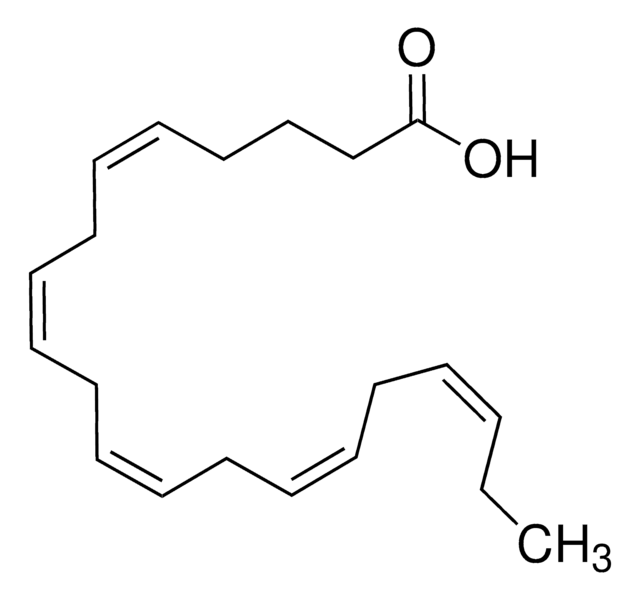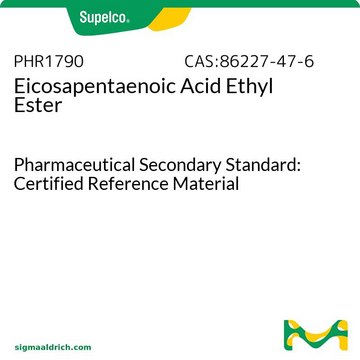E2011
cis-5,8,11,14,17-Eicosapentaenoic acid
from fish oil, ≥99% (GC), liquid, 5-Lipoxygenase inhibitor
Synonym(s):
EPA, Timnodonic acid
About This Item
Recommended Products
product name
cis-5,8,11,14,17-Eicosapentaenoic acid, ≥99%
biological source
fish oil
Quality Level
Assay
≥99%
form
liquid
refractive index
n20/D 1.4977 (lit.)
mp
−54-−53 °C (lit.)
solubility
methanol: 50 mg/mL, clear, colorless
density
0.943 g/mL at 25 °C (lit.)
storage temp.
−20°C
SMILES string
CC/C=C\C/C=C\C/C=C\C/C=C\C/C=C\CCCC(O)=O
InChI
1S/C20H30O2/c1-2-3-4-5-6-7-8-9-10-11-12-13-14-15-16-17-18-19-20(21)22/h3-4,6-7,9-10,12-13,15-16H,2,5,8,11,14,17-19H2,1H3,(H,21,22)/b4-3-,7-6-,10-9-,13-12-,16-15-
InChI key
JAZBEHYOTPTENJ-JLNKQSITSA-N
Gene Information
human ... ALOX5(240)
mouse ... ALOX5(11689) , Pparg(19016)
rat ... ALOX5(25290)
Looking for similar products? Visit Product Comparison Guide
General description
Application
- to test pharmacologic effect on steatosis in hepatocytes
- as an analytical standard in Raman spectra measurements to characterize human breast cancer samples
- in lipid peroxidation assay in mouse embryonic fibroblasts and in pre-treatment of cells for cell viability studies
Biochem/physiol Actions
Storage Class Code
10 - Combustible liquids
WGK
WGK 3
Flash Point(F)
200.1 °F - closed cup
Flash Point(C)
93.4 °C - closed cup
Personal Protective Equipment
Certificates of Analysis (COA)
Search for Certificates of Analysis (COA) by entering the products Lot/Batch Number. Lot and Batch Numbers can be found on a product’s label following the words ‘Lot’ or ‘Batch’.
Already Own This Product?
Find documentation for the products that you have recently purchased in the Document Library.
Customers Also Viewed
Articles
The potential for the prevention and treatment of cardiovascular disease through increased dietary intake of omega-3 (w-3) fish oils is not a recent scientific discovery.
Related Content
Discover Bioactive Small Molecules for Lipid Signaling Research
Our team of scientists has experience in all areas of research including Life Science, Material Science, Chemical Synthesis, Chromatography, Analytical and many others.
Contact Technical Service









